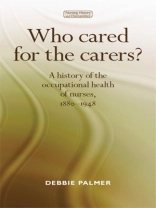This book compares the histories of psychiatric and voluntary hospital nurses’ health from the rise of the professional nurse in 1880 to the advent of the National Health Service in 1948. In the process it reveals the ways national ideas about the organisation of nursing impacted on the lives of ordinary nurses. It explains why the management of nurses’ health changed over time and between places, and sets these changes within a wider context of social, political and economic history. Today, high rates of sickness absence in the nursing profession attract increasing criticism. Nurses took more days off sick in 2011 than private sector employees and most other groups of public sector workers. This book argues that the roots of today’s problems are embedded in the ways nurses were managed in the late nineteenth and early twentieth centuries. It offers insights not only into the history of women’s work but also the history of disease and the ways changing scientific knowledge shaped the management of nurses’ health.
Innehållsförteckning
Introduction
1. ‘To help a million sick, you must kill a few nurses’: the impact of the campaign for professional status on nurses’ health, 1890–1914
2. The First World War and nurses’ choice of occupational representation
3. Nurses’ Registration Act, 1919
4. ‘The disease which is most feared’: the problem of tuberculosis and its threat to nurses’ health, 1880–1950
5. Industrial psychology’s influence on the recruitment and welfare of general and mental nurses, 1930–48
Conclusion
Index
Om författaren
Christine Hallett is Professor of Nursing History at the University of Manchester
Christine Hallett is Reader in Nursing History at the University of Manchester, and Director of the UK Centre for the History of Nursing and Midwifery












